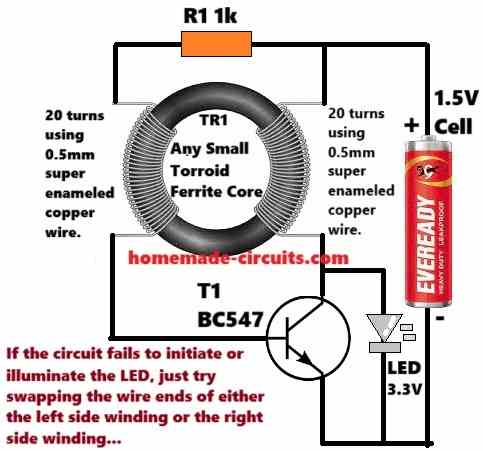There are two main advantages of this highly efficient flashlight circuit with long backup. Firstly, it uses only a single 1.5V AAA cell and illuminates a 3.3V LED. Secondly, the 1.5V cell is consumed by the LED until there's virtually no charge left in it.
Due to these features, this flashlight is able to last many months without the need of frequent replacement of the battery. This ultimately saves money and time for the user.
So, how does this flashlight keeps the LED illuminated until the last drop of charge is used up from the battery?
You guessed it right. This flashlight design incorporates the famous joule thief circuit which enables it to become so efficient.
Circuit Description

If you do not want to read the whole explanation below, you can watch the video instead:
The working of the circuit can be understood with the following points:
This joule thief circuit is actually a blocking type oscillator, also referred to as vampire torch.
When the 1.5V is switched ON, the voltage passes to the base of the T1 BC547 transistor via the R1 1k resistor and the left side winding of TR1.
This switches ON the transistor T1 instantaneously causing the the right side winding to be grounded by the collector/emitter of T1.
Due to this, the full 1.5V now instantaneously gets diverted to ground via the right side winding of TR1 and the T1 collector emitter pins.
In this situation the voltage to the T1 base is momentarily inhibited, causing T1 to turn off instantaneously.
As soon as T1 is turned OFF, the voltage to the right side winding is cut off, causing a boosted flyback voltage to kick-in across the LED.
This instantaneous boosted voltage illuminates the LED brightly.
However, now, the T1 base is yet again able to get the biasing voltage via R1 and the left side winding. T1 is now switched ON, and the ON/OFF cycle simply keeps repeating.
This causes the circuit to oscillate rapidly at a high frequency.
The above high frequency switching of T1 and the TR1 causes the LED to remain constantly illuminated through the boosted voltage frequency from the right side winding.
Due to persistence of vision, the LED appears to be illuminated constantly with high brightness.
The circuit continues to work and keep the LED illuminated until the battery voltage reaches below 0.3V, or until there's hardly any charge left in the 1.5V cell.
Without the above joule thief circuit a 3.3V LED would never illuminate through a 1.5V cell.
If a 3V source is employed using two 1.5V series cells, the LED would illuminate but only until the battery is discharged to 2V. Meaning each cell would still have around 1V left in them, which is then wasted inside the battery.
The above situation is avoided in this circuit, allowing the flashlight LED to work with only a single 1.5V AAA cell and remain illuminated until the cell is completely exhausted.
Because of the features, the proposed LED flashlight becomes 5 times more efficient, long lasting, and extremely economical.
To further enhance the illumination brightness, the LED could be positioned inside a polished reflector base.
Parts List
- Resistor 1k 1/4 watt CFR = 1
- Transistor BC547 or 2N2222 = 1
- LED 3.3V straw hat type = 1
- Transformer using Ferrite ring = 1
- 1.5V AAA Cell = 1
Is TR1 a transformer and if it is, what is the voltage and current rating
The details are given in the diagram…